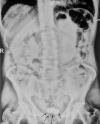Bladder stone formation due to neglected double J stent: a case report
- PMID: 37915707
- PMCID: PMC10617871
- DOI: 10.1097/MS9.0000000000001294
Bladder stone formation due to neglected double J stent: a case report
Abstract
Introduction and importance: Double J (DJ) stents are commonly used in genitourinary procedures, but they can lead to complications including infection, hematuria, encrustation, and stone formation. The longer the duration of encrustation, the greater the risk of complications and renal dysfunction. Forgotten stents pose challenges for patients and can require endourological or open surgical procedures.
Case presentation: A 40-year-old man with hypertension and coronary artery disease had a forgotten DJ stent for 3 years, causing suprapubic pain and dysuria. Kidney, ureter, and bladder (KUB) revealed a coiled DJ stent with a large bladder stone and encrustation, and an open cystolithotomy was successfully performed. Recovery was uneventful, and the patient was discharged without complication.
Clinical discussion: Ureteral stents, including the DJ stent, are commonly used for urological conditions but can cause complications if retained beyond the intended timeframe. Optimal timing for stent removal is crucial, and patients' healthcare knowledge and adherence are critical to preventing retention. KUB X-ray can evaluate stent encrustation and bladder stones. Cystoscopy is the typical approach for stent removal, but supplementary interventions may be necessary. Open surgery was recommended for removing a large bladder stone and encrusted stent in this case.
Conclusion: Timely removal of DJ stents is crucial to avoid complications. Extended retention can cause problems such as encrustation and stone formation. Patient education and adherence are essential to prevent retention and forgetfulness. This case report highlights the importance of careful management of patients with DJ stents for optimal outcomes and prevention of complications.
Keywords: case report; double J stents; encrustation; large bladder stone.
Copyright © 2023 The Author(s). Published by Wolters Kluwer Health, Inc.
Conflict of interest statement
The authors declare that they have no conflicts of interest.
Figures
References
-
- Ringel A, Richter S, Shalev M, et al. . Late complications of ureteral stents. Eur Urol 2000;38:41–44. - PubMed
-
- Pais VM, Jr, Chew B, Shaw O, et al. . Percutaneous nephrolithotomy for removal of encrusted ureteral stents: a multicenter study. J Endourol 2014;28:1188–1191. - PubMed
-
- Singh I, Gupta N, Hemal A, et al. . Severely encrusted polyurethane ureteral stents: management and analysis of potential risk factors. Urology 2001;58:526–531. - PubMed
-
- Agha RA, Franchi T, Sohrabi C, et al. . The SCARE 2020 guideline: updating consensus Surgical CAse REport (SCARE) guidelines. Int J Surg 2020;84:226–30. - PubMed
LinkOut - more resources
Full Text Sources


